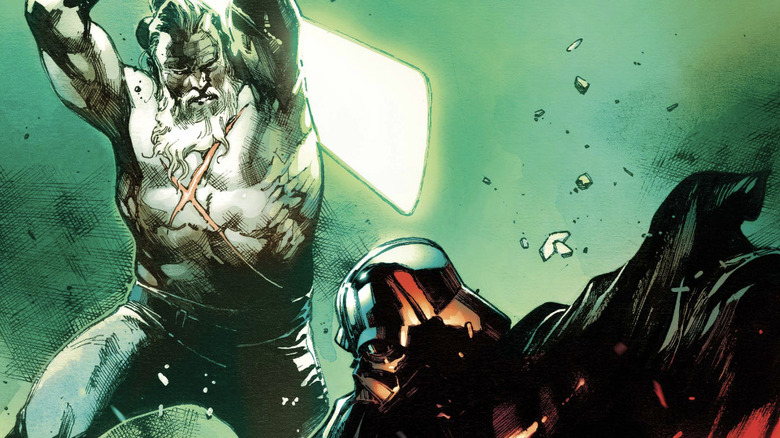The Origin Of Darth Vader's Red Lightsaber Comes From A Lesser Known Star Wars Character
Darth Vader didn't always have a red lightsaber. Early concept art by Ralph McQuarrie (pictured below) shows Vader wielding a blueish-white blade, the same as the Jedi. After all, Vader was always a fallen Jedi (though making him Anakin Skywalker came later).
Whatever the case, the change to red was the right call. The color complements his black armor better, contrasts with the blue and green blades he duels onscreen, and radiates evil. Symbolically, red is also the color of both anger and blood. The red lightsaber is such a memorable part of Vader's presence that when the "Star Wars" prequel trilogy came around, all the Sith Lords there had red lightsabers too. Ergo, red became the de facto color of evil lightsabers.
We first see a lightsaber when Ben Kenobi (Alec Guinness) gives one to Luke (Mark Hamill), saying the blue blade belonged to his father. Indeed it did; when Kenobi strikes down Anakin in "Revenge of the Sith," there's an insert shot of him taking his former friend's lightsaber. If Anakin lost his lightsaber, how'd he have one as Vader?
This is answered in Charles Soule and Giuseppe Camuncoli's (excellent) comic series "Darth Vader: Dark Lord of the Sith", published by Marvel from 2017 to 2018. The run is 25 issues total and spans the early years of the Empire's reign, culminating in Vader building his castle on Mustafar. The first arc, though, begins during "Revenge of the Sith," specifically the scene when the man formerly known as Anakin Skywalker has just awakened in his new armor and been informed his wife Padmé is dead. Darth Sidious gives his apprentice no time to grieve, for a new challenge awaits him: he must acquire the weapon of a Sith.
Kirak Infil'a
Sidious isn't going to just give Vader a new lightsaber, though. His aide Mas Amedda publicly burns all the Jedi's recovered lightsabers in a furnace, signaling the Order is extinct. To get a new lightsaber, Vader will have to kill a Jedi and take theirs. The problem is that Order 66 just annihilated most of them, so Vader looks over a list of suspected survivors.
He selects Master Kirak Infil'a, a Jedi on a pilgrimage; since he wasn't fighting alongside Clone Troopers, he was spared execution by them. Infil'a is an alien of an unnamed species but looks like a grey-skinned human. He also forgoes a shirt, showing a prominent X-shaped scar on his torso. Having taken the "Barash" vow of solitude, Infil'a spends his time on the moon Al'doleem, meditating and sparring with his training droid Arex. Infil'a wields a green lightsaber, which is what Vader wants.
Infil'a defeats Vader in their first battle (depicted in issue #3). Vader steals a training weapon from Arex and duels Infil'a on a dam in front of an Al'doleem city. The Jedi Master, having sensed his brethren's massacre and eager to destroy the "monster" who helped kill them, sends Vader plummeting with the Force.
Unfortunately, Vader lands right near the damaged Arex and repairs his own cybernetics with the droid's body (in the following issue #4). He comes back for round two, this time distracting Infil'a by shattering the dam and flooding the city. Infil'a offers his life and lightsaber for the city; Vader just takes them all.
Later in the series, the hilt on Vader's stolen saber is damaged, so he replaces it with a new design — the one from the original "Star Wars" trilogy (that more closely resembles the one he had as Anakin).
Making a lightsaber bleed
Lightsabers are powered by special, Force-sensitive minerals called Kyber crystals, as seen in "The Clone Wars," "Rogue One," and plenty more media. Why do only the crystals used in Sith's sabers have a red color? It's not just because they're picky about style.
In the original "Star Wars" Expanded Universe (now known as "Star Wars Legends"), the idea consistently referenced was that the Sith's Kyber crystals were synthetically made and more powerful than natural ones. The new "Star Wars" canon (i.e. the original six films, "The Clone Wars," and any new material made after Disney's buyout of Lucasfilm in 2014) has devised a different, and frankly cooler, explanation. Sith bond with their Kyber crystals and corrupt them. They focus their negative emotions into the crystal, bending it to the dark side. The process turns the crystal red, and to reflect this and the violence of the act, it is called "bleeding."
Bleeding was first mentioned in E.K. Johnston's 2016 novel "Ahsoka," but "Darth Vader" issue #5 was the first to show it. Vader takes the crystal from Infil'a's saber and holds it in his hand, concentrating on every tragedy he's lived through and forcing the crystal to share in the pain he feels. The crystal fights back with both explosive energy and a vision trying to guide Anakin back to the light. In the end, though, it bleeds.
Soule later returned to this idea in his 2019 mini-series, "The Rise of Kylo Ren." Ren is not a Sith Lord but he still wields a red lightsaber; the final scene of the comic is him bleeding the crystal. By the end of the process, his hand is soaked in blood too.
If you want to experience this all firsthand, I can't recommend that you read Soule & Camuncoli's "Darth Vader" highly enough.



